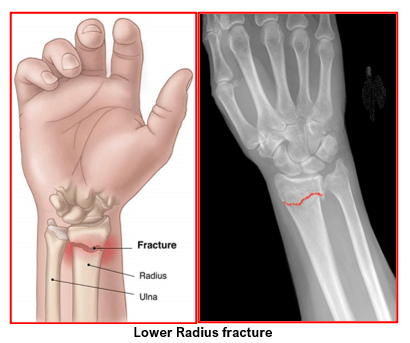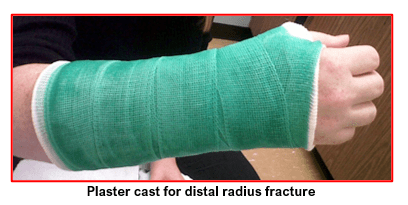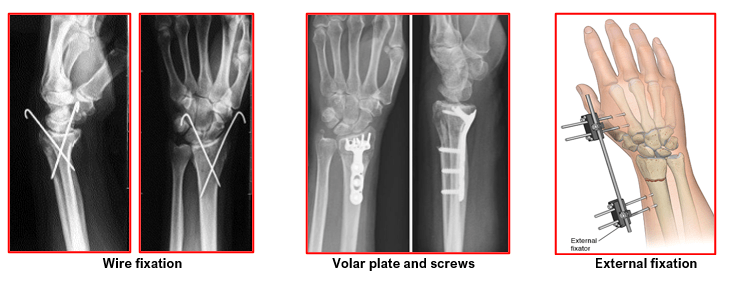Home >> Wrist & Hand Services
Wrist Fractures
The wrist is made up of eight small carpal bones and the two forearm bones, the radius and ulna. The shape of the bones allows the wrist to bend and straighten, move side-to-side, and rotate, as in twisting the palm up or down.
A fracture in the wrist may occur with a low severity injury like a fall onto an outstretched hand. Severe injuries may occur from a more forceful injury, such as a car accident or a fall off a roof or ladder. People who have osteoporosis, are more prone to get wrist fractures as their bones are brittle and weak.

The most commonly broken bone of the wrist is the radius. It may be broken in isolation or along with other bones like the lower ulna or the carpal bones like scaphoid or lunate. These fractures may occur away from the joint surfaces (extra-articular fractures) or they may involve the joint surfaces (intra-articular fractures).
If the fracture fragments have not moved or angulated, then these fractures are called un-displaced fractures.
If the fragments have moved or angulated, then these fractures are called displaced fractures.
Fractures having more than 2 fragments are called comminuted or multi-fragmentary fractures.
The commonly occurring wrist fractures are:
- Colles fracture – fracture of the lower radius with dorsal or backward displacement of the lower fragment.

- Smith’s fracture – fracture of the lower radius with volar or forward displacement of the lower fragment.
- Scaphoid or Lunate fractures
- Barton’s fracture – intra-articular fracture of the lower radius with dislocation of the radio-carpal joint
- Chauffer’s fracture – fracture of the radial styloid.
- Fractures of the ulnar styloid
- Greenstick fractures occur in children
Wrist fractures are diagnosed based on patient’s medical history, clinical examination and x-rays.
Patient will explain how they had their injury. They have wrist pain, swelling, deformity and difficulty in moving their wrist. They have wrist swelling, bruising and tenderness over the fracture site. Wrist movements are painfully limited. Their nerve function is assessed and documented. The distal pulsations are also checked. Patients are provided immediate pain relief and temporary splints are applied before sending them for x-rays. Wrist x-rays are taken to confirm the fracture and know its type.
For several displaced or multi-fragmentary fractures, CT scan of the wrist may be advised. MRI may be needed for small fractures not seen on x-rays or if associated ligament injuries are suspected.
Wrist fractures can be managed by conservative or surgical methods.
Treatment decisions are based on type of fracture, displacement of fragments, stability of the fracture and involvement of joint surfaces. Other important considerations include patient’s age, occupation, activity levels, general health, hand dominance, presence of any prior injury or arthritis, and any associated injuries.
Conservative treatment is used for patients with un-displaced fractures or after manipulation and reduction of displaced fractures under anaesthesia.
- Partial plaster casts (back-slabs) are given for first 7 to 10 days. This provides support and helps reduce pain and swelling. Back-slabs are exchanged for proper fibreglass full plaster cast after 7 days.

- Patients are provided with a shoulder sling or arm pouch. This helps in elevation of their wrist which helps to reduce their pain and swelling.
- Anti-inflammatory medications are given for pain relief.
- Hand elevation is continued for 4 to 6 weeks to reduce swelling and pain.
- Shoulder, elbow and finger movements are encouraged to avoid stiffness.
- Ice packs can be applied over the front portion of their back-slab. This helps reduce swelling and pain.
- Serial check x-rays are done at 1 week, 2 weeks and 6 weeks to ensure that the fracture fragments are maintaining a satisfactory position and have healed well before removal of plaster at 6 weeks.
Surgery is used for management of wrist fractures, if these are:
- Open fractures
- Displaced intra-articular fractures
- Fractures with associated injuries to nerves, blood vessels or surrounding ligaments
- Fractures that are unstable and have moved position with previous conservative treatment
Surgery is performed under general anaesthesia or local regional block.
Fractures may be surgically stabilized with pins (wires), screws, specialised plates and screws, intra-medullary rods, or external fixation depending upon its type and quality of bones.
Arthroscopic assistance may be needed for accurate congruent reduction and fixation of certain intra-articular fractures of the wrist.
Recovery from wrist fracture depends on several factors.
Generally:
- Most wrist fracture heal by 6 to 8 weeks.
- Patients need to carry on wrist and finger exercises for 2 to 3 months to regain full range of movement. Strength may return by 3 to 4 months.
- In some patients, recovery keeps happening gradually and full recovery may take upto 1 year.
- Light work can start by 3 months and heavy work by 6 months
- In high velocity injuries, patients may have niggly pain and stiffness which can take nearly two years to settle down.
Following complications can occur after wrist fractures:
- Damage to median or ulnar nerve
- Compartment syndrome
- Wrist deformity
- Malunion or Non-union of wrist fractures
- Stiffness of wrist
- Carpal instability
- Arthritis of wrist
- Complex regional pain syndrome
- Avascular necrosis of the scaphoid
- Tendon ruptures
Book An Appointment
Private Clinics : Locations & Directions
London Joints Clinic (Pune)
Address
Office S 5, 2nd Floor, North Block, Sacred World Mall,
Opp Sacred Heart Township, Near Jagtap Chowk,
Wanawadi, Pune 411040
Monday to Saturday
6 PM to 9 PM
Appointments
Hospitals OPDs : Locations & Directions
Jupiter Hospital (Baner)

Address
Lane 3, Baner- Balewadi Road,
Prathamesh Park,
Baner, Pune 411 045
Monday to Saturday 11 AM to 4 PM
Appointments
Contact us
Dr Anand Jadhav has a centralised appointment system for all locations across various hospitals and clinics in Pune & PCMC areas
Appointment Bookings & Requests can be made by any method :

